
I so wanted to see the Hope Diamond
I was prepared to trade; Bear wanted to go to the Space Museum and the Spy
Museum, so I added the butterfly collection and we called it quits. The
history of the stone which was eventually named the Hope diamond began when the
French merchant traveller, Jean Baptiste Tavernier, purchased a 112 3/16-carat
diamond. This diamond, which was most likely from the Kollur mine in Golconda,
India, was somewhat triangular in shape and crudely cut. Its color was described
by Tavernier as a "beautiful violet." Tavernier sold the diamond to King Louis XIV of France in 1668
with 14 other large diamonds and several smaller ones. In 1673 the stone was
recut by Sieur Pitau, the court jeweler, resulting in a 67 1/8-carat stone. In
the royal inventories, its color was described as an intense steely-blue and the
stone became known as the "Blue Diamond of the Crown," or the "French Blue." It
was set in gold and suspended on a neck ribbon which the king wore on ceremonial
occasions.
King Louis XV, in 1749, had the stone reset by
court jeweler Andre Jacquemin, in a piece of ceremonial jewelry for the Order of
the Golden Fleece (Toison D'Or). In 1791, after an attempt by Louis XVI and
Marie Antoinette to flee France, the jewels of the French Royal Treasury were
turned over to the government. During a week-long looting of the crown jewels in
September of 1792, the French Blue diamond was stolen.
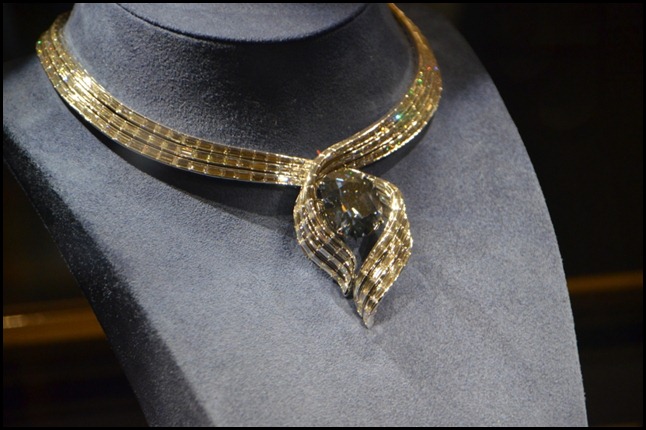
In 1812 a deep blue diamond described by John
Francillion as weighing 177 grains (4 grains = 1 carat) was documented as being
in the possession of London diamond merchant, Daniel Eliason. Strong evidence
indicates that the stone was the recut French Blue and the same stone known
today as the HopeDiamond. Several references suggest that it was acquired by
King George IV of England. At his death, in 1830, the king's debts were so
enormous that the blue diamond was likely sold through private channels.
The first reference to the diamond's next owner is found in
the 1839 entry of the gem collection catalog of the well-known Henry Philip
Hope, the man from whom the diamond takes its name. Unfortunately, the catalog
does not reveal where or from whom Hope acquired the diamond or how much he paid
for it. Following the death of Henry Philip Hope in 1839, and after
much litigation, the diamond passed to his nephew Henry Thomas Hope and
ultimately to the nephew's grandson Lord Francis Hope. In 1901 Lord Francis Hope
obtained permission from the Court of Chancery and his sisters to sell the stone
to help pay off his debts. It was sold to a London dealer who quickly sold it to
Joseph Frankels and Sons of New York City, who retained the stone in New York
until they, in turn, needed cash. The diamond was next sold to Selim Habib who
put it up for auction in Paris in 1909. It did not sell at the auction but was
sold soon after to C.H. Rosenau and then resold to Pierre Cartier that same
year.
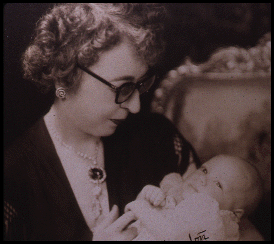
In 1910 the Hope diamond was shown to Mrs.
Evalyn Walsh McLean, of Washington D.C., at Cartier's in Paris, but she
did not like the setting. Cartier had the diamond reset and took it to the U.S.
where he left it with Mrs. McLean for a weekend. This strategy was successful.
The sale was made in 1911 with the diamond mounted as a headpiece on a
three-tiered circlet of large white diamonds. Sometime later it became the
pendant on a diamond necklace as we know it today. Mrs. McLean's flamboyant
ownership of the stone lasted until her death in 1947. Harry Winston Inc. of New York City purchased Mrs. McLean's
entire jewelry collection, including the Hope diamond, from her estate in 1949.
This collection also included the 94.8-carat Star of the East diamond, the
15-carat Star of the South diamond, a 9-carat green diamond, and a 31-carat
diamond which is now called the McLean diamond. For the next 10 years the Hope diamond was shown at many
exhibits and charitable events worldwide by Harry Winston Inc., including as the
central attraction of their Court of Jewels exhibition. On November 10, 1958,
they donated the Hope diamond to the Smithsonian Institution, and almost
immediately the great blue stone became its premier attraction.

Photo from the formal
presentation of the Hope Diamond to the Smithsonian on the 10th of
September 1958.
From left to right: Mrs. Harry Winston,
wife of the donor; Leonard Carmichael, Secretary of the Smithsonian; Dr. George
S. Switzer, Curator of Mineralogy.
The Hope diamond has left the Smithsonian only four times
since it was donated. In 1962 it was exhibited for a month at the Louvre in
Paris, France, as part of an exhibit entitled Ten Centuries of French Jewelry.
In 1965 the Hope diamond traveled to South Africa where it was exhibited at the
Rand Easter Show in Johannesburg. In 1984 the diamond was lent to Harry Winston
Inc., in New York, as part of the firm's 50th anniversary celebration. In 1996
the Hope diamond was again sent to Harry Winston Inc., in New York, this time
for cleaning and some minor restoration work. The weight of the Hope diamond for many years was reported to
be 44.5 carats. In 1974 it was removed from its setting and found actually to
weigh 45.52 carats. It is classified as a type IIb diamond, which are
semiconductive and usually phosphoresce. The Hope diamond phosphoresces a strong
red color, which will last for several seconds after exposure to short wave
ultra-violet light. The diamond's blue coloration is attributed to trace amounts
of boron in the stone. In the pendant surrounding the Hope diamond
are 16 white diamonds, both pear-shapes and cushion cuts. A bail is soldered to
the pendant where Mrs. McLean would often attach other diamonds including the
McLean diamond and the Star of the East. The necklace chain contains 45 white
diamonds.
In December of 1988, a team from the Gemological
Institute of America visited the Smithsonian to grade the great blue stone using
present day techniques. They observed that the gem shows evidence of wear, has a
remarkably strong phosphorescence, and that its clarity is slightly affected by
a whitish graining which is common to blue diamonds. They described the color as
a fancy dark grayish-blue. An examination on the same day by another gemologist
using a very sensitive colorimeter revealed that there is a very slight violet
component to the deep blue color which is imperceptible to the naked eye. Still,
one can only wonder that the original 112 3/16-carat stone bought by Tavernier
was described as "un beau violet" (a beautiful violet). I actually only saw it
as a grey stone.
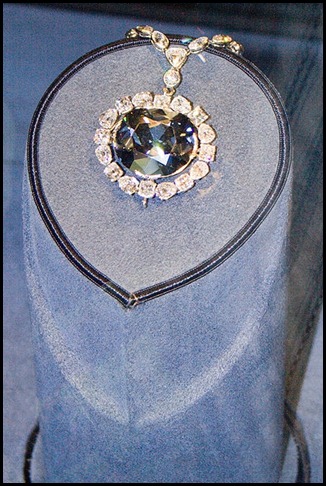
1653: Tavernier. 116 metric carats. Value 220,000 – 720,000 livres.
Tavernier received Patent of Nobility as part payment worth 450,000 livres.
Acquired between 1640-1667, possibly 1653.
1673: King Louis XIV. Triangular-shaped 69 metric carats set on a cravat
pin in 1674. It was bequeathed to King Louis XV.
1722: King Louis XV. Assembled into elaborate pendant Order of the Golden
Fleece. Bequeathed to King Louis XVI.
1775. King Louis
XVI. 69 metric carats. Was stolen.
1792: Uncertain ownership.
1805: King George IV. Conflicting claims over
ownership.
1830: Daniel Eliason, a London jeweller. 45.52 carats. Valued at $65,000
to $90,000. May have been acting as an agent for Henry Phillip Hope. Bequeathed
to Thomas Hope.
Became
known as the hope Diamond.
1839: Thomas Hope. Diamond displayed at the 1851 London Exhibition.
Bequeathed.
1861: Henry Pelham-Clinton. Hope gave it to his daughter after she married
the 6th Duke of Newcastle.
1884: Lord Francis Hope. Value $250,000.
1894: May Yohe (wife of Lord Henry Francis Hope). 29,000 pounds (2010
value 2,245,350 pounds).
1901: Adolph Weil, London jewel merchant.
$141,032.
1901: Simon Frankel.
1908: Selim Habib.
1908: Sultan Abdul Hamid (disputed). Weight 44 and 3/8 carats. 400,000
francs.
1909: Simon Rosenau. Value 550,000 francs.
1910: Pierre Cartier. Reset to appeal to Evalyn McLean; diamond mounted as
a head piece on three-tiered circlet of large white diamonds; became pendant.
Conflicting values, $150k, $185k or $300k+
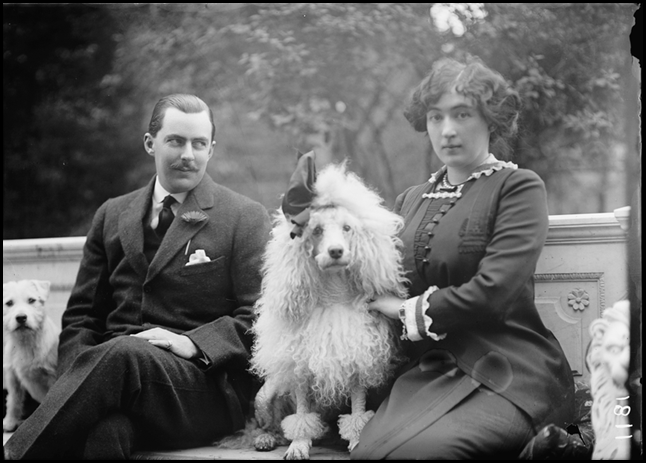
1911: Edward Beale McLean and Evalyn Walsh
McLean. Weight thought to be 44.5 carats. Sold for an undisclosed sum.
1947: Harry Winston bought entire McLean collection. Diamond’s bottom
facet slightly recut to increase brilliance.
1958: Smithsonian Museum. Found to be 45.52 carats in 1974 today’s value
$200-$250 million.
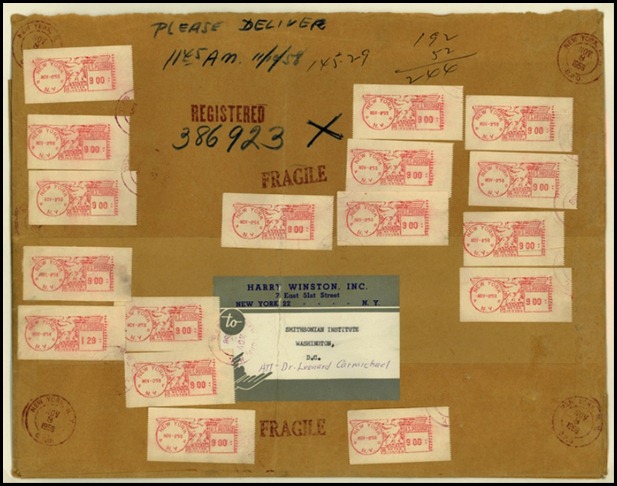
Smithsonian ownership:
Smithsonian mineralogist George Switzer is
credited with persuading Harry Winston to donate the Hope Diamond to the
Smithsonian National Museum of Natural History for a proposed national gem collection to be housed
at the museum. On the 10th of November 1958, Winston donated the diamond to the
Smithsonian Institution, where it became Specimen #217868, sending it
through U.S. Mail in a box wrapped in brown paper, insured via registered mail at a cost of $145.29.
Winston had never believed in any of the tales about the curse; he donated the
diamond with the hope that it would help the United States "establish a gem
collection." Winston died many years later, in 1978, of a heart attack.
Winston's gift, according to Smithsonian curator Dr. Jeffrey Port, helped spur
additional gifts to the museum.
For
its first four decades in the National Museum of Natural History, the Hope Diamond lay in its necklace inside a
glass-fronted safe as part of the gems and jewelry gallery, except for a few
brief excursions: a 1962 exhibition to the Louvre;
the 1965 Rand Easter Show in
Johannesburg, South Africa; and two visits back to Harry Winston's premises in
New York City, once in 1984, and once for a 50th anniversary celebration in
1996.
When
the Smithsonian's gallery was renovated in 1997, the necklace was moved onto a
rotating pedestal inside a cylinder made of 3-inch thick bulletproof glass in
its own display room, adjacent to the main exhibit of the National Gem
Collection in the Janet Annenberg Hooker Hall of Geology, Gems, and Minerals.
The Hope Diamond is the most popular jewel on display and the collection's
centerpiece. In 2005,
the Smithsonian published a year-long computer-aided geometry research which
officially acknowledged that the Hope Diamond is, in fact, part of the stolen
French Blue crown jewel.
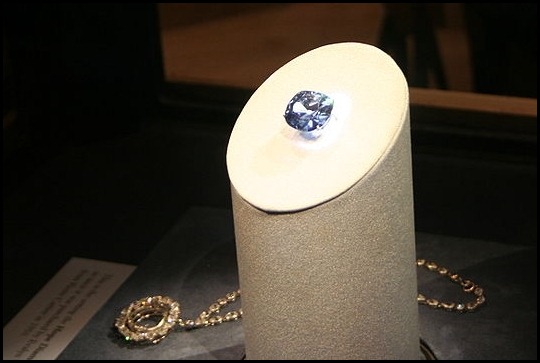
In
2009, the Smithsonian announced a
temporary new setting for the jewel to celebrate a half-century at the
Museum. Starting in
September 2009, the 45.52-carat diamond will be exhibited as a stand-alone gem
with no setting. It was removed from its setting for cleaning from time to time,
but this is the first time it will be on public view by itself. Previously it
had been shown in a platinum setting, surrounded by 16 white pear-shaped and
cushion-cut diamonds, suspended from a chain containing forty-five
diamonds.
The Hope
returned to its traditional setting in late 2010.
On the 18th
of November 2010, the Hope Diamond was unveiled and displayed at the Smithsonian
in a temporary newly-designed necklace called "Embracing Hope," created by the
Harry Winston firm. Three designs for the new setting, all white diamonds and
white metal, were created and the public voted on the final version. The Hope
Diamond also is resting on a new dark blue neck form, which the Harry Winston
firm commissioned from display organization, Pac Team Group. Previously, the
Hope Diamond had been displayed as a loose gem since late summer of 2009 when it
was removed from its former Cartier-designed setting. A Smithsonian curator
described it as "priceless" because it was "irreplaceable", although it was
reported to be insured for $250 million. In 2012 the diamond will be returned to
its historic setting, and the current necklace will be implanted with another
diamond worth "at least a million dollars," and the necklace with the new
diamond will be sold to benefit the Smithsonian.
In 2010,
the Smithsonian licensed its gem and jewelry collection to create a "line of
bracelets, brooches and other baubles" to be sold on the TV shopping network
QVC; the jewelry line will not have real diamonds, but will serve as costume
jewelry with semiprecious stones, and benefits the museum by being an additional
source of revenue.
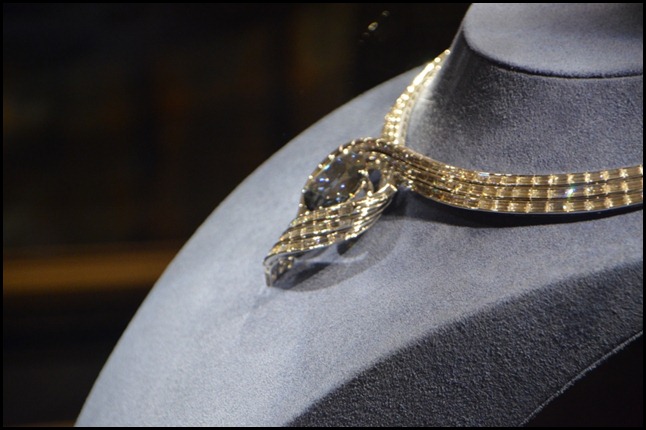
ALL IN ALL QUITE A
JOURNEY


